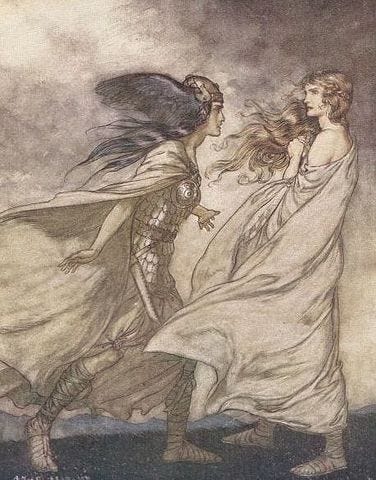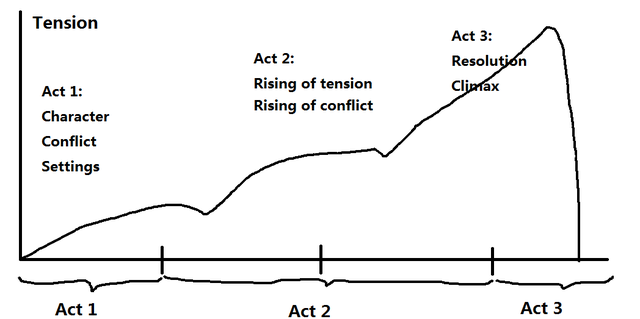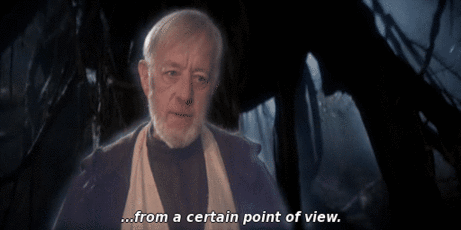K F E Trahndorff Asthetics or Theory of Philosphy and Art
Why Y'all Should Sentinel All 6 Star Wars Films in Numerical Order
A Example for a Completionist Star Wars Literary Theory

Originally published at electricdidact.weebly.com equally "From a Certain Bespeak of View: The Example for a Completionist Star Wars Literary Theory"
Kickoff things first, There'south been an awakening. Can you lot feel it?

Star Wars Episode Vii: The Force Awakens is coming out in most a month! Dec 18, 2015 volition be a day long remembered. I can already feel the disturbance in the forcefulness, equally if millions of voices suddenly cried out in excitement, and were suddenly silenced [by reverence for the opening crawl, by a John Williams smackdown, or possibly by fainting]. Simply at that place has been another disturbance in the force. And information technology smells similar bantha poodoo.
The Trouble: Viewing Order
To exist off-white, this is a perennial problem: In what club does 1 watch the Star Wars films? Episodes IV through Half-dozen were released between 1977 and 1983; episodes I through Three (known as the prequels) were released between 1999 and 2005. By starting "in media res," George Lucas threw the world into anarchy. The trouble is familiar, just the stakes are college. This time, the sorry souls who have somehow never seen the epic saga are coming out of the woodwork under the social pressure to encounter December's long-awaited release. "Really, I've never seen Star Wars," they say. (See? Bantha poodoo if I always saw it.) And and then their friends, family, meaning others — every sane person, basically — engage in what can only be described every bit egregious face-palmery, followed by neckband-grabbery and mandatory viewing of what I believe to be one of the greatest and most epic science-fantasy epics e'er to be epic-ized through the epic epicenter of the ballsy Television set'due south epic light rays landing on my epic epidermis. (!!!)
And here is where I tell y'all who you are. You are a Star Wars fan. (If you don't really intendance for Star Wars, I find your lack of faith disturbing; go out of my sight.) You accept seen the movies once, hopefully multiple times earlier. You lot are versed in the implications of my opening statements, that dissimilar other moving-picture show series, Star Wars presents the curious conundrum of which social club to place the films: in order of release, in story/chronological order, or perhaps using the so-called "machete" solution.
Three Schools of Criticism
What follows is a brief introduction to the three schools of Star Wars criticism as I accept observed and dubbed them. In parentheses beside each theory is the proposed viewing order.
1) Completionism (I-2-3-Four-Five-Vi)
Completionists acknowledge Lucas' ultimate vision for Star Wars as encompassing a complete (go it?) story arc consisting of the rising and fall of Anakin Skywalker/Darth Vader. Completionists may tend to value character development over plot details. As such, they watch all six episodes in story/chronological order: I through VI. I'll leave off any further give-and-take of this schoolhouse, since I'll exist explaining a bit more afterward.
2) Purism (IV-V-Six)
Purists tend to be literarily conservative and seek consistency of product value and aesthetic. They besides tend to favor plot-driven rather than wistful or character stories. And they also hate Jar Jar. Therefore, they ideally prefer to picket the three original films — IV through Half dozen — rather than or at least before the prequels. More specifically, Purists tend to dislike the turn toward CGI (computer-generated imagery) in the prequels or even in the Special Edition (1997) versions of episodes 4 through VI (though most have probably made their peace with information technology past now). Other criticisms of the prequels include bad acting on the role of those films' younger actors (Jake Lloyd, Hayden Christensen, Natalie Portman). In general, I accept observed Purist arguments to rest upon grounds of
- Aesthetic (e.yard., criticisms of attribute or plausibility, such as "That lightsaber cantankerous baby-sit thing doesn't fifty-fifty wait practical," or "You wouldn't be able to hear explosions in space.")
- Arts and crafts/Production (e.g., criticisms of such production aspects as writing, acting, sequencing, directing, etc.)
- Canon (due east.k., using the greater Star Wars oeuvre, including but not limited to movies, TV serial, novels, documents, etc. to contend for what Star Wars "should take been" or "should be" or "actually is")
- Intuition (east.thou., argument in terms of likes/dislikes, expectations/disappointments; I would also argue that the "intuition" line of reasoning contextualizes Purists' want to preserve the surprise of the famous "I am your father" scene in episode Five; these experiential aspects of Purist theory usually chronicle dorsum to both aesthetic and craft)
In curt, the "purity" that Purism seeks could exist described in terms of the compositional concepts of consistency, design, and promise keeping (expectation/fulfillment).
3) Machete-ism/Sciomeliorism (Iv-5-Ii-Three-VI)
This school of thought, initiated by Rod Hilton, a software blogger (not surprising), takes Purism to new heights of creativity and (dare I say it — I do) insult. This theory cuts (or should I say hacks) episode I entirely and inserts 2 and Iii in between V and VI. Hilton's original blog post is long, but here's an excerpt quoted by Fourth dimension back in Apr:
"Equally I mentioned, this [machete method] creates a lot of tension after the cliffhanger ending of Episode V. Information technology also uses the original trilogy equally a framing device for the prequel trilogy. Vader drops this huge bomb that he'southward Luke'southward father, so we spend two movies proving he's telling the truth, then we run across how it gets resolved."
(Time besides cites the most notable benefits of the machete order as "a whole lot less Jar Jar Binks and super-whiny Male child Anakin.") I've dubbed this theory "Machete-ism" afterwards Hilton'southward coinage, or "Sciomeliorism" (skee-oh-MEHL-yor-ism; my own coinage), from the [probably bad] Latin for "I know better." Substantially, Sciomeliorists rearrange the pieces to avoid what they don't like and better the series with a sort of flashback in the eye. On one hand, laudable for its creativity; on the other, problematic for Completionists.
Which brings us to my defense. Aye, my defence, considering if it is not articulate by now, I am a self-styled Completionist through and through (though in my more than generous moments I can at least enjoy a pseudo-friendly Rogerian argument with the Purists).
The Completionist Case
The Completionist approach comprises several primary arguments, but each rests upon a more than general agreement of film as literary text. We can derive from this understanding a serial of bounds to inform our arguments:
a) Completionism accepts the text as it is and on its own terms, acknowledging reader intuitions but trying not to argue from them. (One may non "like" how Shakespeare wrote Hamlet, but ane puts that dislike bated in society to engage with the text every bit it is; annihilation else is exploratory, and while interesting, is something unlike from what we're doing.)
b) The needs of the audition/reader (that is, problems of craft or aesthetic) are subordinated to the fact of the text'south past, current, and changing character; that is, Completionists acknowledge, even revel in the universe'south transitory and evolving nature at the easily of multiple authors. (Purists, on the other hand, tend not to appreciate post-hoc changes to or hierarchializations of "canon" artifacts.)
c) The choices of the author are acknowledged and important and open to criticism, just can get — at a certain distance from the text — irrelevant to it. Many criticisms of Star Wars take focused on George Lucas himself, resorting to ad hominem reasoning (certainly in terms of episode I and specifically in terms of Jar Jar) which Completionism tends to turn down every bit invalid for criticism of the text: the Star Wars films. These premises being laid down, nosotros can now propose the following theses that, taken together, I believe lend some substance to the Completionist case for a I-through-Six viewing club:
Thesis 1) Episodes I through Vi stand for a unified piece of work as understood within the Wagnerian concept of Gesamtkunstwerk.
Whorl with me, guys. Insofar as Star Wars is a text, we can further empathize it in terms of genre. Besides beingness categorized as a space opera, Star Wars could exist characterized every bit generally operatic, peculiarly as compared with the operatic works of writer and composer Richard Wagner (1813–1883). Wagner took the German term Gesamtkunstwerk, first used by philosopher K.F.E. Trahndorff, and applied information technology to his work, particularly to the opera series Der Ring des Nibelungen (The Band of the Nibelung), often called The Ring Cycle.

Gesamtkunstwerk has been interpreted as "total artwork" or "synthesis of the arts," referring, as Wikipedia claims, to the idea of using "all or many art forms" in a unified work. Wagner attempted this with The Ring Cycle. Co-ordinate to this theory, "Such a work of art was to be the clearest and well-nigh profound expression of a folk fable, though abstracted from its nationalist particulars to a universal humanist fable." Star Wars, equally theorists such as Joseph Campbell have argued, certainly participates in the idiom of folk legend. And removing the story from whatsoever specific Earth-bound setting into the imaginative-yet-accessible "galaxy far, far away," Star Wars successfully universalizes its narrative by abstraction. And as a gesamtkunstwerk, the work equally a whole satisfactorily combines theater, music (for orchestra, phonation, electronic instruments, etc.), ii-dimensional art (traditional as well as digital matte paintings), iii-dimensional art (droid and set sculptures), etc.
In so doing, the story of episodes I through 6 take part in the sweeping, epic, character-driven tropes that sustain Wagner's Band Cycle, too every bit non-comedic opera more generally.
Thesis 2) The text makes its own argument for a chronological viewing order.
Of course, the "total artwork" thesis could be applied to whatever single episode without having to encompass all vi episodes. Just if nosotros go on our example from Wagner's Ring Bicycle, then we can argue that for Wagner, the iv-function gesamtkunstwerk was intended to exist performed in series, even though productions over the years have occasionally presented individual performances separately. Likewise, the text of Star Wars itself argues for a chronological viewing social club. That the episodes' titles are explicitly numbered further lends weight to the Wagnerian argument to view each function of the whole in its serial. The Purist instance for a release-order viewing must rest outside the text. But the text suggests that beginning with episode IV is arbitrary. That episode is titled "A New Hope," which implies that at that place was previously none, or even perhaps an "old hope." In fact, in that location was, namely that of the "chosen one" prophecy whose shaky promise (and subsequent disillusion) ties together episodes I through III and enables further evolution of the example in readings of Anakin and Luke Skywalker in episodes Iv through VI. That the throughline of Anakin Skywalker/Darth Vader is maintained and adult in all six episodes is a farther example that all six episodes — neither the halved Purist format nor the truncated Machete guild — found essentially a single work. This point is elaborated in the tertiary thesis.
Thesis 3) Episodes I through Half dozen comprise a nested three-act arrangement, with Anakin representing the superstructure and Luke representing the substructure.
The three-act structure, comprising setup/exposition, confrontation/rising activeness, and climax/resolution, is a standard model used in screenplay writing. While many individual stories and films use this plot model, I would argue that Star Wars episodes I through VI contain an overarching three-part structure, unified by the graphic symbol arc of Anakin Skywalker, with Luke Skywalker's graphic symbol arc serving equally a nested 3-act substructure that supports its antecedent toward resolution. Like many movies in this mode, the first and last acts are shorter than the start.

Borrowing from the verbiage of the above-linked Wikipedia article, I will loosely demonstrate how this works.
Deed I: Exposition (Episodes I and II) The first two episodes "constitute the main characters [Anakin, Padme, Obi-Wan Kenobi, Yoda, Palpatine, etc.], their relationships [principal/apprentice, romantic attachments, comrades, etc.] and the world they live in [Republic, Tatooine, Coruscant, etc.]." Afterward in this human action, "a dynamic, on-screen incident occurs that confronts the principal character [Anakin, whose mother dies in his arms]. Anakin's "attempts to deal with this incident [i.e., his promise to become then powerful that he can overcome death itself, angry fighting, selfish loving] lead to a second and more dramatic situation, known as the first turning signal," which, according to this model, signals the cease of the kickoff human activity with a promise that "life will never be the same again for the protagonist." We can certainly say this is then with the end of episode Two: Anakin loses his arm in his offset brush with death itself (his nominal foe, one could argue), and he marries Padme in secret as a sort of seal on his promise to his dead female parent.
Act 2: Rising Activeness (Episodes III, 4, Five, and Half-dozen-a) This second act "depicts the protagonist's [Anakin'due south] attempts to resolve the trouble initiated past the first turning point [the pursuit of ability in social club to overcome death], simply to find himself in ever worsening situations [conflicting loyalties, plough to the dark side, Padme's death, Galactic civil war, unwittingly fighting with children]." As the model suggests, Anakin'south disability to resolve his problems is because he does non however take the skills to deal with them [in this instance, dearest, empathy, selflessness, etc.]. Anakin must "make it at a higher sense of awareness" of who he is — Anakin the Good or Vader the Evil — and what he is capable of (love, selflessness, fatherhood), in order to deal with his predicament. "This cannot be achieved lone and [the protagonist is] usually aided and abetted by mentors and co-protagonists," the commodity explains. Hence, this 2d deed of the Anakinian superstructure contains the ii start acts of the Lukean substructure. Luke, in this paradigm, serves as Anakin's abetting mentor, going through his own three-act character arc in society to achieve a signal where he can finally reckon with his father and help him to come to the aforementioned cocky-awareness.
Act III: Resolution (Episode VI-b) The final awareness procedure, as the article explains, changes who the protagonist is. Vader changes. It is Anakin, not Darth Vader, who overthrows Palpatine and answers the dramatic question posed at the end of Act I: Can Anakin get powerful enough to defeat expiry itself? No. Anakin, in his new sensation, accepts expiry and thus conquers it, in a way, for his family and arguably for himself (since he appears alongside Obi-wan and Yoda in the final shot). Thus, the nested construction not only tracks classic operatic themes (hubris, decease, and consequences), but also makes an argument through that structure about the intricacy, complication, and power of man relationships. Mentors upon mentors, friends upon friends, ultimately work toward the redemption of a person about had assumed too far gone to apologize. And that's why Completionists sentry episodes I through Vi in that order.
Conclusion
All snark and humor aside, this defense is not intended to disqualify the Purist Star Wars theory (though I do concord Sciomeliorism in contempt). My defense of the chronological viewing social club doesn't mean that problems of arts and crafts, aesthetic, and intuition are dumb questions or meaningless. They're but not the questions Completionists similar me usually find the most interesting. Every bit a friend and fellow Star Wars fan reminded me every bit I was writing this, episode Seven has the capacity to disappoint. It could throw off my brilliant three-deed argument, for all I know! I for i am excited that the saga continues with new characters, new struggles, and new explorations through the universe I've come to honey.
In the terminate, the thing to remember is that we all beloved Star Wars. Purists and Completionists. Just mostly Completionists. Am I right?

What other schools of thought are there on Star Wars and how i should view the films?

Originally published at electricdidact.weebly.com .
Source: https://medium.com/panel-frame/why-you-should-watch-all-6-star-wars-films-in-numerical-order-624165b1c8f2